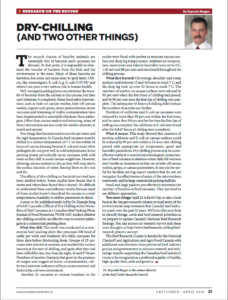Dry Chilling (and two other things)
This article written by Dr. Reynold Bergen, BCRC Science Director, originally appeared in the April 2016 issue of Canadian Cattlemen magazine and is reprinted on the BCRC Blog with permission of the publisher.
The muscle tissues of healthy animals are essentially free of bacteria until carcasses are skinned. At that point, it is impossible to eliminate the transfer of bacteria from the hide and the environment to the meat.
Many of those bacteria are harmless, but some can cause meat to spoil faster. Others, like verotoxigenic E. coli (e.g. E. coli O157:H7 and others) can pose a very serious risk to human health. Well-managed packing plants can minimize the transfer of bacteria from the animal to the carcass, but they can’t eliminate it completely. Many food safety interventions such as hide-on carcass washes, hide-off carcass washes, organic acid sprays, steam pasteurization, steam vacuums and trimming of visible contamination have been implemented to essentially eliminate these pathogens. Other than carcass washes and trimming, many of these interventions are too costly for smaller abattoirs to install and operate.
Two things that bacteria need to survive and grow are water and the right temperature. In Canada, beef carcasses must be chilled to a surface temperature of 7°C or less within 24 h of carcass dressing because E. coli and many other associated pathogens do not grow well in cold temperatures. Some packing plants periodically spray carcasses with cold water as they chill to avoid carcass weight loss. However, allowing carcasses surfaces to dry as they chill may starve the surface bacteria of water, forcing them to dry out and die. The effects of dry-chilling on bacterial survival have been studied before. Some studies have found that it works and others have found that it doesn’t. It’s difficult to understand these contradictory results, because most of these studies haven’t described the carcass or cooler temperatures, humidity or airflow parameters in detail.
A soon-to-be-published study led by Dr. Xianqin Yang of AAFC Lacombe (Effects of Dry Chilling on the Microflora of Beef Carcasses at a Canadian Beef Packing Plant; Journal of Food Protection 79:538-543) studied whether dry-chilling could be an effective way to control pathogens in a commercial packing plant.
What they did
This study was conducted at a commercial beef packing plant that processes 200 head of cattle per week and routinely dry-chills carcasses for three days before fabricating them. Groups of 25 carcasses were selected at random, and swabbed for surface bacteria at the start of chilling, and again after they had been chilled for 1, 2, 4, 6, 8, 24 and 67 hours. Numbers of aerobes (bacteria that grow in the presence of oxygen and are indicators of general hygiene), coliforms (common indicators of fecal contamination) and Escherichia coli were determined. Other carcasses at various locations in the cooler were fitted with probes to measure carcass surface and deep leg temperatures. Ambient air temperature, movement and relative humidity were set to 0°C, 1.65 m/s and 88% and monitored throughout the chilling process.
What they learned
On average, shoulder and rump surfaces took between 13 and 16 hours to reach 7°C, and the deep leg took up over 32 hours to reach 7°C. The numbers of aerobes on carcass surfaces was reduced by 90% when the first hour of chilling had passed, and by 99% once the first day of chilling was complete. The subsequent 43 hours of chilling didn’t reduce the numbers of aerobes any further. Numbers of coliforms and E. coli on carcasses were reduced by more than 90% within the first hour, and by more than 99% by the time the first day of chilling was complete. No coliforms or E. coli were found after the full 67 hours of chilling were completed.
What it means
This study showed that numbers of aerobes, coliforms and E. coli on carcass surfaces could be reduced by 99% within a 24 hour dry chilling period with appropriate air temperature, speed and humidity parameters. Dry chilling process may be a cost-effective method to control microbiological contamination of beef carcasses in abattoirs where daily kill volumes don’t justify an investment in hide-on or hide-off carcass washes, sprays, or carcass pasteurizers. It may also be useful for facilities serving export markets that do not yet recognize the effectiveness of some of the interventions commonly used in large commercial packing facilities. Small and large packers can both produce carcasses that are essentially bacteria-free. They just need to use different approaches.
Two more things
April 22 is Earth Day, so take a look back at the January research column to recall some of the environmental improvements that Canada’s beef industry made over the past 30 years. We’d also like your help to identify forage, cattle and beef research priorities as we prepare to update Canada’s National Beef Research Strategy.
You can access our research survey and share your thoughts until May 31.
Click here to subscribe to the BCRC Blog and receive email notifications when new content is posted.
The sharing or reprinting of BCRC Blog articles is typically welcome and encouraged, however this article requires permission of the original publisher.
We welcome your questions, comments and suggestions. Contact us directly or generate public discussion by posting your thoughts below.
